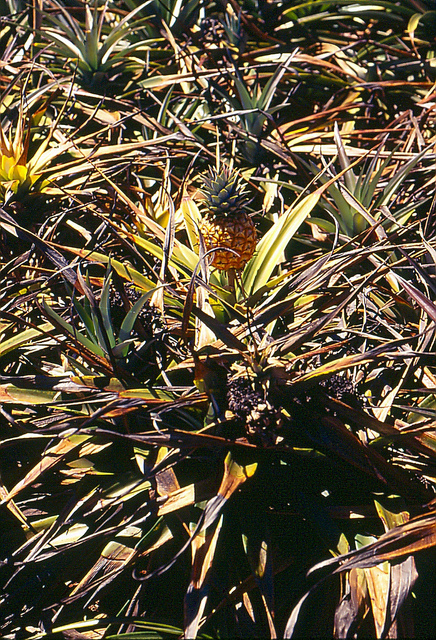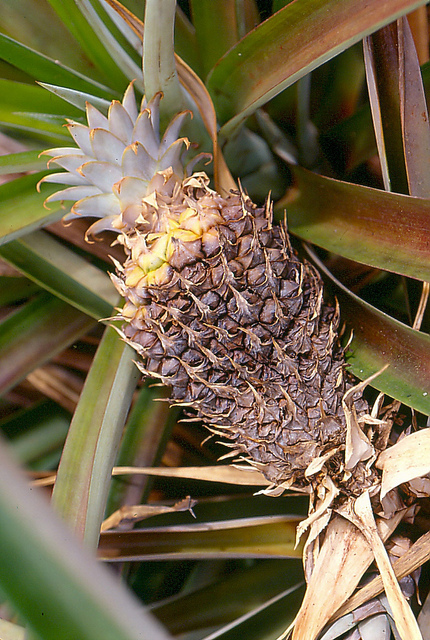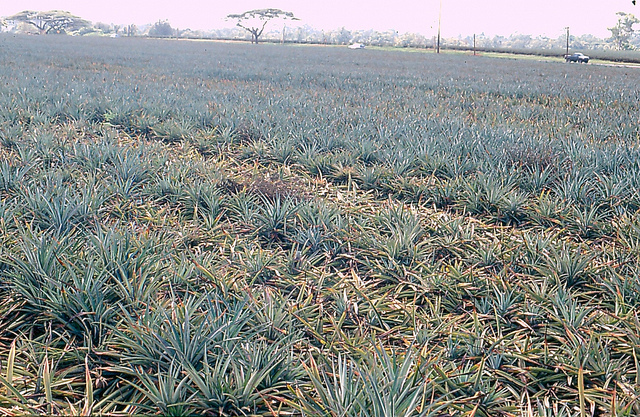Pineapple
Description
Uses
Propagation
References
Common Pests and Diseases
Diseases
Category : Bacterial
Bacterial heart rot and fruit collapse Erwinia chrysanthemi
Symptoms
Water-soaked lesions on the white basal sections of leaves in the central whorl which may spread to all leaves in the central whorl; midportions of leaves become olive green in color with a bloated appearance; infected fruits exude juices and the shell becomes olive green; cavities form within the fruit
Cause
Bacterium
Comments
Disease is thought to be spread from the juices of infected fruits; bacteria in the juice can enter leaves through wounds; ants acts as vectors for the bacteria
Management
Remove and destroy infected fruits; avoid the use of infected crowns for seed material to prevent spread of the disease; planting to avoid flowering when adjacent field is fruiting can reduce disease development; use of miticides and control of ants can significantly reduce disease incidenceCategory : Fungal
Butt rot, Black rot & White leaf spot Chalara paradoxa
Symptoms
Soft black rot which begins at the area where the seed piece detaches from the mother plant; entire seed piece may be rotted; black rot of fruit causes a soft, watery rot which darkens with time; small brown, wet spots develop on leaves; leaf spots enlarge and turn gray-brown with light brown margins
Cause
Fungus
Comments
Fungus survives in soil and pineapple residue; infects plants through fresh wounds
Management
Seed material should be stored on mother plants during dry weather and with good air circulation; freshly removed seed material should be dipped in an appropriate fungicide within 12 hours of removal from the mother plant; avoiding bruising and wounding of fruit during harvest helps to reduce black rot; harvested fruit should be dipped in an appropriate fungicide within 6-12 hours of harvest to prevent disease development during shippingCategory : Other
Marbling
Acetobacter spp.
Erwinia herbicola
Symptoms
Yellow to red or very dark brown discoloration of fruit flesh; infected tissues develop a granular texture with woody consistency and speckled color; single or multiple fruitlets may be affected; vascular system may appear speckled right down to core of fruit; symptoms develop during the last month of fruit maturation
Cause
Bacteria
Comments
Emergence of the disease is favored by warm, wet weather
Management
There are currently no methods of controlling the disease; the pineapple variety Smooth Cayenne appears to be moderately resistant to the diseaseCategory : Viral
Mealybug wilt Pineapple wilt virus (PWV)
Symptoms
Leaves turning red; tips of leaves become withered and turn brown; plants can be easily removed from the soil
Cause
Virus
Comments
Virus is transmitted by mealybugs; ants protect mealybug populations from predators and parasites and can allow mealybugs populations to reach very damaging levels if left uncontrolled
Management
Ants should be controlled with an appropriate insecticideCategory : Oomycete
Phytophthora heart and root rot Phytophthora spp.
Symptoms
Young leaves failing to elongate and turning chlorotic; heart leaves wilting and turning brown; terminal whorl can be easily pulled from mother plant; water-soaked tissue at base of leaves; foul smell; leaves may be turning red and yellow with necrotic leaf margins and leaf tips; plants can easily be pulled out of the ground; fruits color prematurely
Cause
Oomycete
Comments
Fungi can survive in soil and plant debris for many years
Management
Planting in raised beds helps to drain the soil and reduces incidence of the disease; mulch from pineapple debris should be avoided; pre-planting dips and foliar applications of Fosetyl Al are very effective at controlling the diseasePests
Category : Insects
Mealybugs (Pineapple mealybug) Dysmicoccus brevipes
Symptoms
Flattened oval to round disc-like insect covered in waxy substance on tree branches; insects attract ants which may also be present; insect colony may also be associated with growth of sooty mold due to fungal colonization of sugary honeydew excreted by the insect; plants may show symptoms of mealybug wilt (see entry)
Cause
Insect
Comments
Insects have a wide host range; often tended by ants which farm them for their sugary honeydew secretions; transmit mealybug wilt in pineapple












